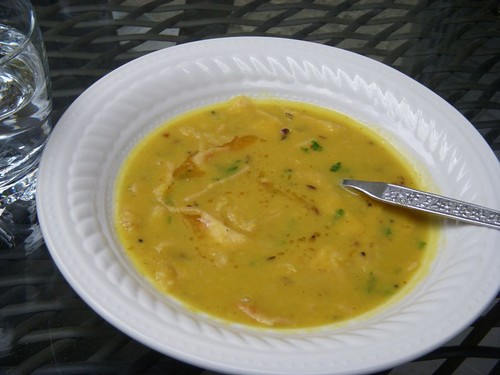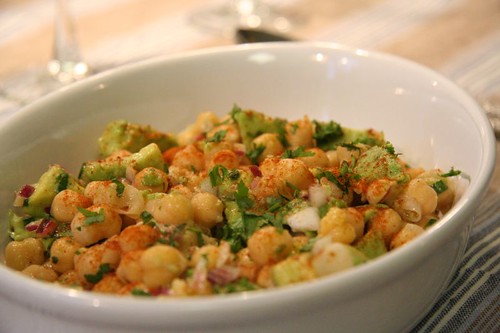Just a little dal, and some spicesFor over a year now, I had been working on a project that kept me more busy that ever, with little time to spare for anything else. It used to be one crazy day after another, always racing against time. The good news is that even while I was extremely busy, I did manage to cook regularly. Perhaps more regularly than I did before, because sometimes even going out to eat was out of question.
As time was scarce, most of the cooking was simple fare that did not need me to look through recipes. There were everyday sabjis, dals, common sense pastas, rice dishes, eggs, and so on, where I could play with things on hand without having to worry about botching it up. Plenty of produce focused food, salads for lunch, fruit for dessert. Simple without skimping on flavor was always the goal. Occasional treats, recipes to try, and experiments were left for the weekend, if at all.
During this period, I also lost ten pounds, went to India, gained the ten pounds back (yes, in that order), and went to India again, but with no weight changes this time around.
I managed to make a post every few months, but when it came to reading my favorite blogs, checking feeds, or participating in events, I was hopelessly out of synch. Now I am waking up from a Rip Van Vinkle-ish sleep in the blog world. And wait, what's this I find - I have followers? Wow, who knew!
With this post I commemorate a recipe that has become a favorite in the last year or two. It just came together one day when I needed a quick and satisfying solo meal, but all I had was a scant cup of leftover plain
waran, one solitary roti, and very little time or energy to do much. It was so out of this world that it got made again and again, and again, to the point where I made it my own.
The starting point is the Cooker's super duper
Chincha Gulaachi Aamti, which is a very typical sweet sour dal from Maharashtra. While dals of all kinds are a common part of most Indian meals, they only rarely take center stage, and even more rarely are they paired with something other than rice.
Perhaps that is why the last part of her post caught my eye
"As children, we'd also eat amti with poli. Crumble a couple of polis in a bowl, a ladle full of amti and some toop."
That is exactly what I did, for a meal that kept me going all day. Naturally, with protein from the dal, and hardly any starch, it was the perfect lunch for a working day.
Using her original recipe, I usually add a dried red chili for a kick, and some cumin seeds to the phodni. Sometimes I replace tamarind with aamsul (dried kokum) if I don't have time to soak tamarind to make the paste.
This could be considered as a shortcut version of chakolya or waran phale, in which strips of dough are cooked in dal, similar to
Dal Dhokli, for those familiar with it. Or a pasta in split pea sauce deal if you must. However, at this point, I don't have a real name for it, other than
'that dal dhokli like thing with aamti and polis, which is unbelievably comforting and tasty'.
Can two plain leftovers combine to produce something that delicious? Try it for yourself and decide. I had someone declare that they could eat this
every day.
 Everyday Aamti with Poli
Everyday Aamti with PoliServes 2
Ingredients2 cups waran, or cooked toor dal
1 Tablespoons oil
1/2 teaspoon mustard seeds
pinch of asafetida powder
1/2 teaspoon turmeric
1/2 teaspoon fenugreek (methi) seeds
4-7 curry leaves
1-2 dried red chilies, broken into pieces
1/2 teaspoon cumin seeds
2 teaspoons tamarind paste or 2 pieces of aamsul
1-1/2 tsp goda masala
1 Tablespoon jaggery
2-3 polis (or rotis, chappatis, phulkas), leftover are fine
2 Tablespoons chopped cilantro (optional)
1 teaspoon of ghee (optional, but highly recommended)
MethodWhisk the cooked dal with a fork or whisk.
Cut the polis into 2 semicircles, stack them, and cut into 1/2 inch wide strips with kitchen scissors.
In a large wide pan, heat the oil. When hot, add the mustard seeds, and as they pop, follow with methi seeds, asafetida, turmeric, curry leaves, chili, and cumin seeds.
Add the cooked daal, tamarind paste, goda masala, jaggery, and salt.
Add a little water if necessary, and bring to a boil. It needs to be somewhat liquid-y at that this point, as the dal will thicken as it cooks. Turn off the heat after boiling for a couple of minutes when it starts to thicken.
Add in the pieces of poli and cilantro and stir gently.
Serve within minutes in wide bowls, with a swirl of homemade ghee on top. The ghee is not necessary, but makes a difference!
Sending this over to the fabulous Sra, who is hosting the Legume Love Affair. Here's how the affair carries on.
Glossary I realized that I take a lot of terms in this post for granted, but might need explanation for some, so I decided to add this reference guide.
waran: plain toor dal, usually cooked with about 3-4 times water by volume and a pinch of turmeric. 1/2 cup of dried toor dal yields about 2 cups waran.
poLI: thinly rolled out chappatis, a standard component of every marathi meals, akin to whole wheat flour tortillas.
toop: ghee (in Hindi), clarified butter.
phoDNI: tempering of dry spices in hot oil.
goDA masAlA: a marathi spice blend that is usually made at home with scores of ingredients. These days it is even available in Indian stores in the US.




























